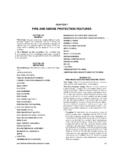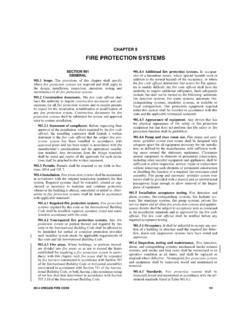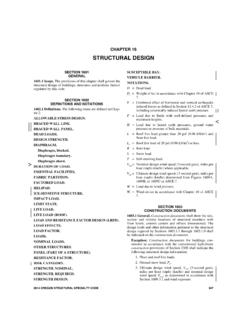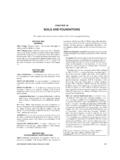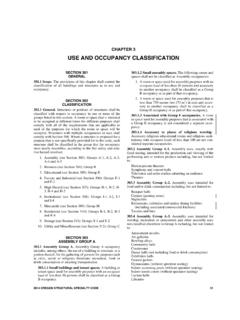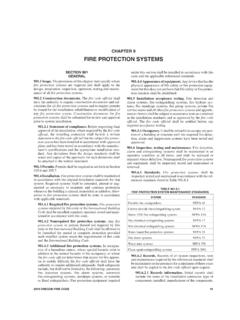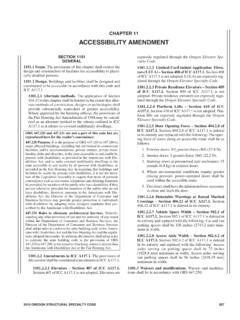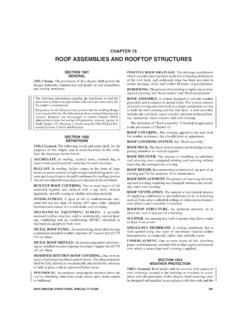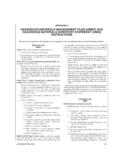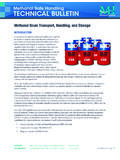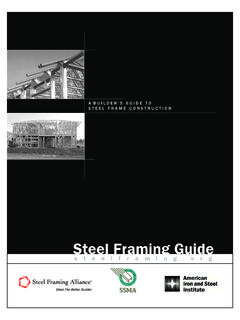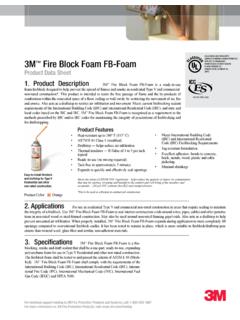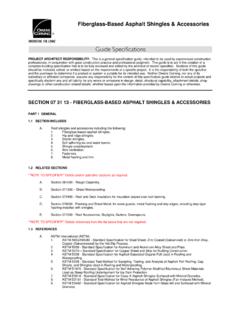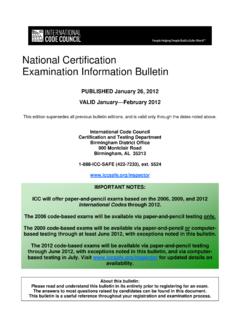Transcription of CHAPTER 3 GENERAL REQUIREMENTS
1 CHAPTER 3 GENERAL REQUIREMENTSSECTION provisions of this CHAPTER shall govern theoccupancy and maintenance of all structures and premises forprecautions against fire and the spread of fire and generalrequirements of fire shall be required as set forth in for the activities or uses regulated by Sections 306, 307,308 and following words and terms shall, for thepurposes of this CHAPTER and as used elsewhere in this code,have the meanings shown outdoor fire utilized for ceremonial cart used to transport hot roofing materials on TRANSMISSION electricalpower transmission line operating at or above 66 burning of materials wherein prod-ucts of combustion are emitted directly into the ambient airwithout passing through a stack or chimney from an enclosedchamber.
2 Open burning does not include road flares,smudgepots and similar devices associated with safety or occu-pational uses typically considered open flames,recreationalfiresor use of portable outdoor fireplaces. For the purpose ofthis definition, a chamber shall be regarded as enclosed when,during the time combustion occurs, only apertures, ducts,stacks, flues or chimneys necessary to provide combustion airand permit the escape of exhaust gas are OUTDOOR portable, out-door, solid-fuel-burning fireplace that may be constructed ofsteel, concrete, clay or other noncombustible material. A porta-ble outdoor fireplace may be open in design, or may beequipped with a small hearth opening and a short chimney orchimney opening in the INDUSTRIAL forklift, tractor,platform lift truck or motorized hand truck powered by an elec-trical motor or internal combustion engine.
3 Powered industrialtrucks do not include farm vehicles or automotive vehicles forhighway outdoor fire burning materialsother than rubbish where the fuel being burned is not containedin an incinerator, outdoor fireplace, portable outdoor fireplace,barbeque grill or barbeque pit and has a total fuel area of 3 feet(914 mm) or less in diameter and 2 feet (610 mm) or less inheight for pleasure, religious, ceremonial, cooking, warmth orsimilar 303 ASPHALT (tar) kettles shall not be trans-ported over any highway, road or street when the heat sourcefor the kettle is :Asphalt (tar) kettles in the process of patchingroad (tar) kettles shall not be locatedwithin 20 feet (6096 mm) of any combustible material, com-bustible building surface or any building opening and within acontrolled area identified by the use of traffic cones, barriers orotherapprovedmeans.
4 Asphalt (tar) kettles and pots shall notbe utilized inside or on the roof of a building or structure. Roof-ing kettles and operating asphalt (tar) kettles shall not blockmeans of egress, gates, roadways or Location of fuel containers shall belocated at least 10 feet (3048 mm) from the :Containers properly insulated from heat orflame are allowed to be within 2 feet (610 mm) of the operating kettle shall be attended by aminimum of one employee knowledgeable of the operationsand hazards. The employee shall be within 100 feet (30 480mm) of the kettle and have the kettle within sight. Ladders orsimilar obstacles shall not form a part of the route between theattendant and the Fire shall be a portable fire extin-guisher complying with Section 906 and with a minimum40-B:C rating within 25 feet (7620 mm) of each asphalt (tar)kettle during the period such kettle is being utilized.
5 Addition-ally, there shall be one portable fire extinguisher with a mini-mum 3-A:40-B:C rating on the roof being (tar) kettles shall be equipped with tight-fitting shall be constructed of noncombusti-ble materials. Hi- boys shall be limited to a capacity of 55 gal-lons (208 L). Fuel sources or heating elements shall not beallowed as part of a Roofing kettles shall be constructed ofnoncombustible OREGON FIRE CODE35 ORS and ORS are not a part of this code butare reproduced or paraphrased here for the reader s defines the parameters for obtaining a fire per-mit, limitations on burning and record defines certain materials that are permitted tobe burned only with the permission of the fire chief and burn-ing schedules and :\data\CODES\STATE CODES\Oregon\2010\Fire\Final VP\ , November 17, 2009 12:33:28 PMColor profile.
6 Generic CMYK printer profileComposite Default Fuel containers under air containersthat operate under air pressure shall not exceed 20 gallons (76L) in capacity and shall be 304 COMBUSTIBLE WASTE Waste accumulation wastematerial creating a fire hazard shall not be allowed to accumu-late in buildings or structures or upon Waste of wastepaper,wood, hay, straw, weeds, litter or combustible or flammablewaste or rubbish of any type shall not be permitted to remainon a roof or in anycourt, yard, vacant lot, alley, parking lot,open space, or beneath a grandstand,bleacher, pier, wharfor other similar , grass, vines or other growththat is capable of being ignited and endangering property,shall be cut down and removed by theowneror occupant ofthe premises.
7 Vegetation clearance REQUIREMENTS inurban-wildland interface areas shall be in accordance withtheInternational Wildland-Urban Interface Space underneath underneathgrandstand and bleacher seats shall be kept free from com-bustible and flammable materials. Except where enclosedin not less than 1-hour fire-resistance-rated construction inaccordance with theInternational Building Code, spacesunderneath grandstand and bleacher seats shall not beoccupied or utilized for purposes other thanmeans of combustible rubbish shall not pro-duce conditions that will create a nuisance or a hazard to thepublic health, safety or rubbish, and waste materialkept within or near a structure shall be stored in accordancewith Sections through Spontaneous susceptible tospontaneous ignition, such as oily rags, shall be stored in alisteddisposal container.
8 Contents of such containers shallbe removed and disposed of Capacity exceeding cubic a capacity exceeding cubic feet (40 gallons)( m3) shall be provided with lids. Containers and lidsshall be constructed of noncombustible materials or ofcombustible materials with a peak rate of heat release notexceeding 300 kW/m2when tested in accordance withASTM E 1354 at an incident heat flux of 50 kW/m2in thehorizontal :1. Wastebaskets in Group I-3 occupancies shall com-ply with Section Dumpsters or containers in areas as approved bythe authority having jurisdiction shall be protectedby an approved automatic sprinkler systeminstalled throughout in accordance with , or Storage in a structure shall not be prohibited wherethe structure is of Type I or IIA construction,located not less than 10 feet (3048 mm) from otherbuildings and used exclusively for dumpsters orcontainer Capacity exceeding cubic containers with an individual capacity of cubicyards [ cubic feet ( m3)] or more shall not be storedin buildings or placed within 5 feet (1524 mm)
9 Of combusti-ble walls, openings or combustible roof eave :1. Dumpsters or containers in areas protected by anapproved automatic sprinkler systeminstalledthroughout in accordance with Section , or Storage in a structure shall not be prohibited wherethe structure is of Type I or IIA construction,located not less than 10 feet (3048 mm) from otherbuildings and used exclusively for dumpster orcontainer Capacity of 1 cubic yard or withan individual capacity of cubic yard [200 gallons ( )] or more shall not be stored in buildings or placed within5 feet (1524 mm) of combustible walls, openings or com-bustible roof eave lines unless the dumpsters are constructedof noncombustible materials or of combustible materialswith a peak rate of heat release not exceeding 300 kW/m2when tested in accordance with ASTM E 1354 at an incidentheat flux of 50 kW/m2in the horizontal :1.
10 Dumpsters in areas protected by anapprovedautomatic sprinkler systeminstalled throughout inaccordance with Section , Storage in a structure shall not be prohibited wherethe structure is of Type I or IIA construction,located not less than 10 feet (3048 mm) from otherbuildings and used exclusively for dumpster orcontainer 305 IGNITION Clearance from ignition betweenignition sources, such as luminaires, heaters, flame-producingdevices and combustible materials, shall be maintained in Hot ashes and spontaneous ignition , cinders, smoldering coals or greasy or oily materialssubject to spontaneous ignition shall not be deposited in a com-bustible receptacle, within 10 feet (3048 mm) of other combus-tible material including combustible walls and partitions orwithin 2 feet (610 mm) of openings to.
